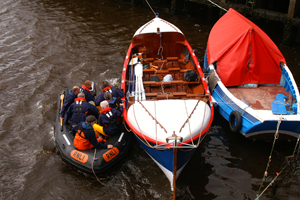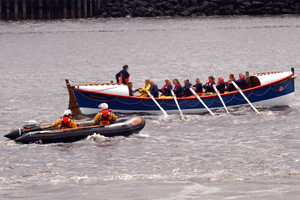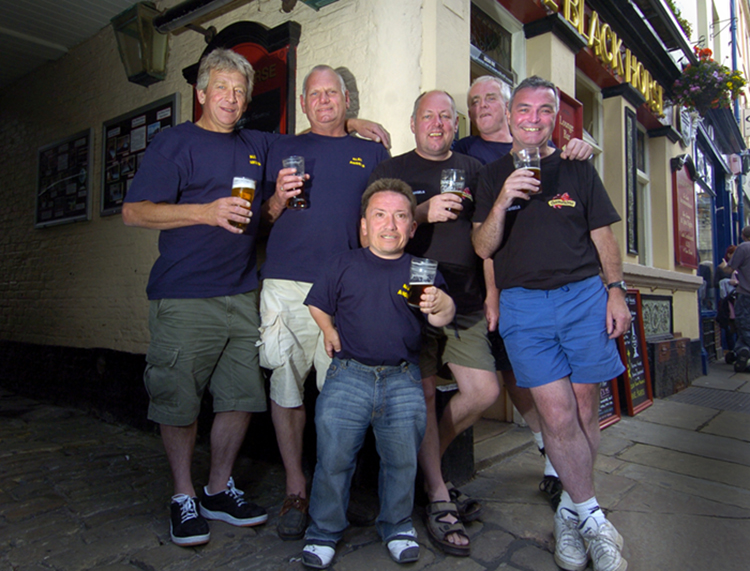
Henry Vernon Revival Row
After the completion of the restoration and the official unveiling the trust moved onto its first true fund raising venture and perhaps one of the biggest challenges the trust may face. After the Rohilla had run aground a number of attempts were made to rescue those still trapped aboard the doomed vessel. It was accepted however, that only a motor lifeboat could affect rescue with the closest one to hand being the Tynemouth lifeboat "Henry Vernon". In perilous conditions the motor lifeboat made the 60 mile journey in a strong gale and under the same blackout conditions that had spelt the end for the Rohilla. The challenge of recreating the same journey in the William Riley is a bold statement in itself, more so when one considers the Henry Vernon was a motor lifeboat quite unlike the ten oars the William Riley is limited to. It seems amazing feats of human spirit are something the restored lifeboat has at its heart, as if being lowered down a perpendicular 200 foot cliff in 1914 is not enough.
The reconstruction of the Henry Vernon's feat was undertaken by a six-strong group from York who achieved fame travelling the length of Loch Lomond on a pedalo. The group, who have called themselves Ales Angels, are expected to row 12 miles each day, with the support of additional crew from lifeboat stations along the route. The boat arrived at Tynemouth, her first port of departure with overnight stops at Sunderland, Hartlepool and Staithes before embarking on its final leg to its home port of Whitby to arrive towards the culmination of Whitby's Lifeboat Weekend on July 13th. The schedule for the recreation of the Henry Vernon's was as follows.
Date |
Leg |
| 10th July | Tynemouth to Sunderland |
| 11th July | Sunderland to Hartlepool |
| 12th July | Hartlepool to Staithes |
| 13th July | Staithes to Whitby |
"It is without doubt going to be quite a challenge," the boat weighs around two tonnes, with a six knot tidal current as just one of many hurdles the team will face as they make their way down the coast." As it makes its final arrival there is sure to be plenty of praise for all those who have played a role in the fundraising venture. It was hoped that people and businesses would have come forward to sponsor various options of the venture ranging from a woolly hat to the oars and perhaps the boat itself. The aim was to raise up to £50,000 which would then be shared between Tynemouth, Sunderland, Hartlepool, Staithes and Whitby lifeboat stations.
Former trustee Tim Hicking is scheduled to play his part on the Sunderland to Hartlepool leg and also the final leg from Staithes to Whitby. Knowing Tim's commitment and enthusiasm for the William Riley he can be assured of a warm welcome at Whitby and I know he will take great pride in being there from the outset seeing the project through to its completion. It is simply astounding to have seen the transformation the former lifeboat went through from being found in an almost derelict state to how it is now! She is now destined for a healthy future raising money for the Royal National Lifeboat Institution (RNLI) while a permanent home for her is sought.
Route Leg Reports
Stage One - Tynemouth to Sunderland

On the 10th July, at 1320 hrs, the former Upgang / Whitby lifeboat “William Riley of Birmingham & Leamington” left Tyneside on the first leg of a five stage fundraising row from Tynemouth to Whitby. At Tynemouth the weather was unconditionally gusty and it seemed all the hard work planning the fund raising row might have been in jeopardy. Members of the current lifeboat crew along with some of those attempting the row assessed conditions at the breakwater, only then could a decision on whether it was safe to embark on the first leg be made!

The William Riley was held alongside the Tynemouth lifeboat station so that the intrepid volunteers could make themselves as comfortable as possible with such a venture. The challenge ahead is undoubtedly one that is going to push the limits of those engaged in rowing a 34 foot, 99 year old ex-lifeboat. As the boat was towed into the centre of the river and free of any affordable wind protection it was clear the task ahead was not going to an easy one. Peter Thompson, a former lifeboat coxswain himself guided the volunteers on the complexities of working as a team as the boat ventured towards the mouth of the Tyne. Working against the tide and strong winds the first leg took three hours as opposed to the two hours anticipated and the team no doubt took great comfort in being able to take it in turns to row and also coxswain the boat. William Riley arrived at Sunderland Marina, flanked by Tynemouth and Sunderland lifeboats.
It was hoped that the rowers would be wearing the smocks, kapok lifejacket's and red woolly hats that were expected as they departed from and arrived at each of the stations en route, especially as the boat makes it to Whitby?
Stage Two – Sunderland To Hartlepool
Four of the Sunderland lifeboat crew, Sam Grant, Jon Pollock, Duncan Gomes and Anthony Jobling will be among the 10 strong team of oarsmen for the second leg from Sunderland down to Hartlepool when the William Riley was due to depart at around 1400 hours. The weather forecast was looking more settled and it is hoped it will not impede the progress of journey.
Mr Jobling said: "It's a fantastic opportunity for current RNLI volunteers to turn the clock back almost 100 years and experience what it was like to form part of a lifeboat crew using manual oar power alone."
Stage Three – Hartlepool To Staithes
The former Upgang lifeboat William Riley continues its fund raising row from Tyneside to Whitby, embarking on its third leg from Hartlepool to Staithes. The restored lifeboat left Hartlepool at 1430 hours in breezy but bright conditions escorted by the “BBC Radio Cleveland” an Atlantic 75 lifeboat stationed at Hartlepool as well as a small yacht and the pleasure craft “Saray” a familiar visitor to Whitby during the summer months.
The William Riley will make its final overnight stop at Staithes before departing on the final leg of what has been a valiant challenge. The old lifeboat is assured a warm welcome when it arrives at Whitby to coincide with the town’s annual lifeboat weekend. The boat will take part in the Blessing of the Boats at 3pm to complete what is undoubtedly a huge undertaking.
Stage Three – Hartlepool To Staithes
The William Riley lifeboat left Hartlepool at 1430 hours in breezy but bright conditions escorted by the “BBC Radio Cleveland” an Atlantic 75 lifeboat stationed at Hartlepool as well as a small yacht and the pleasure craft “Saray” a familiar visitor to Whitby during the summer months.
After setting off in what was looking like a beautiful day, the weather forecast expected did not materialise. The wind became a very strong north west on top of a three metre swell. Part way down the coast the rowers had to endure a storm and heavy rain making it heavy going. The third stage was definitely the most gruelling lasting around six hours, the rowers most grateful to get ashore after such hard work.
Stage Four – Staithes To Whitby
On the Sunday the row from Staithes was very nearly cancelled because of difficulties getting out of the harbour but once out it was a run for Whitby. Having departed from Staithes this leg was without doubt the one, which epitomised the challenge set by the Whitby Historic Lifeboat Trust. One cannot help but praise all those that played their role rowing each of the legs from Tyneside. Having been at Tyneside and Hartlepool and the arrival at Whitby I can testify to the challenging conditions faced by those rowing the former Upgang / Whitby lifeboat. I have added a small photograph of the "Ales Angels", however a larger one can be viewed using the link on the photograph itself.
The Ales Angels
Graham Hughes, Steve Cook, Graham Chaddock, Syd Scott, David Foster & Steve Morrison
As one of those in the small flotilla that escorted the William Riley into Whitby harbour, it was overwhelming to see the huge crowds that had gathered along the full length of the piers. The arrival had been planned to coincide with the climax of the town’s lifeboat weekend so as to add something totally unique to the many facets of the lifeboat presentations, indeed those visitors present can thank themselves as such an event may never be repeated. The William Riley was berthed alongside the lifeboat pier so it could form part of the annual Blessing of the Fleet. Dignitaries and visitors were seated to listen to the band and witness the arrival of the lifeboat in a one off special event.
As if anything were needed to enhance the occasion, the Rohilla's bell was situated at the lifeboat station after having recently been found. Patricia Harrowing had loaned the bell for the weekend to those who had worked tirelessly to make the weekend so special. The former lifeboat was rescued from certain destruction and completely restored as a founding member of the trust set up to oversee the restoration I feel quite proud to have played my own role. The William Riley is something the whole town should be proud of, as it is a tangible piece of our maritime heritage, something many towns and cities cannot lay claim to.
I have a good selection of photographs relating to the adventurous challenge in recreating the 60 mile journey the Henry Vernon took in 1914 in extremely poor conditions and one can only wonder at how difficult it must have been. Although the Henry Vernon was a motor lifeboat this would not have reduced the perilous nature of the journey down the north east coast. The four gallery pages can be accessed using the links below.
Description |
Link |
| Tynemouth | Gallery One |
| Hartlepool | Gallery Two |
| Whitby Arrival Pt 1 | Gallery Three |
| Whitby Arrival Pt 2 | Gallery Four |
The fundraising row took four days, covering the 60 miles the rowers had to manually row 316.680 strokes, without doubt an impressive count. At each of the lifeboat stations down the coast there was an abundance of crew who were only too willing to assist the six Ales Angels (below) as well also providing a priceless escort for the William Riley.
I enquired within the RNLI as to when we might hear news of the fundraising success, they could only tell me that they estimated news at the end of the year. I later received an e-mail from the trust treasurer in which he eluded to knowing I had been making enquiries about the money raised during the event. I was told the trust were still waiting for the money from the other lifeboat stations, but that the local contribution was well over £7k. He asked me to not publicise anything on my website as the trust was planning to release the actual overall figure as part of a major public relations hook? I initially conceded to his request, expecting in vain to see something released. Later enquiries within the RNLI revealed that £5456 had been raised locally, this is an admirable amount going towards a worthy cause, although it raises questions about the "7k that I had been told had been raised locally". As a very popular station Whitby has done well to raise this amount, it remains to be seen what the other stations have raised but I have my doubts about the £50.000 the trust was hoping to raise.
I have taken great comfort knowing that I was one of the founding trustees for the Whitby Historic Lifeboat Trust accepting I had my own role to play in getting the lifeboat to the stage it is at today. Whatever the rights or wrongs about the way in which the certain trustees behaved nothing can take away the fact that I was willing to step up as a trustee.
Use the following link to access the first of four Tynemouth to Whitby gallery pages.
Copyright © Colin Brittain 1999 - 2022
